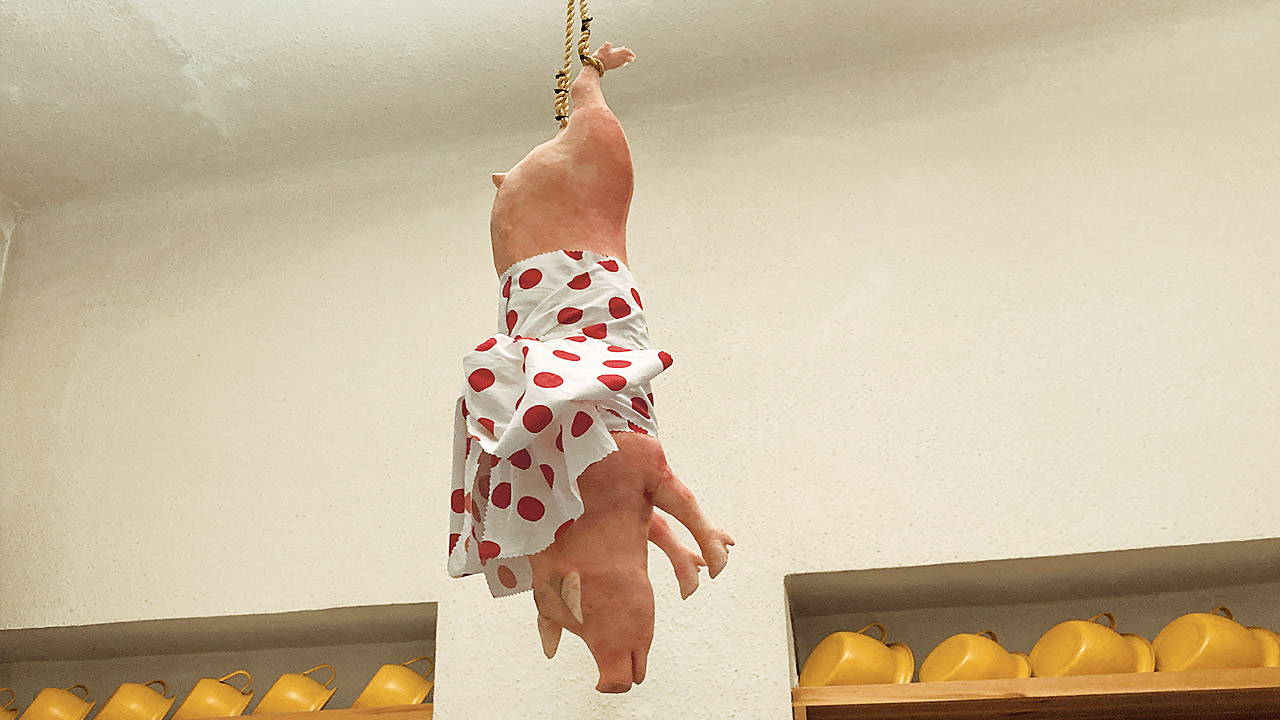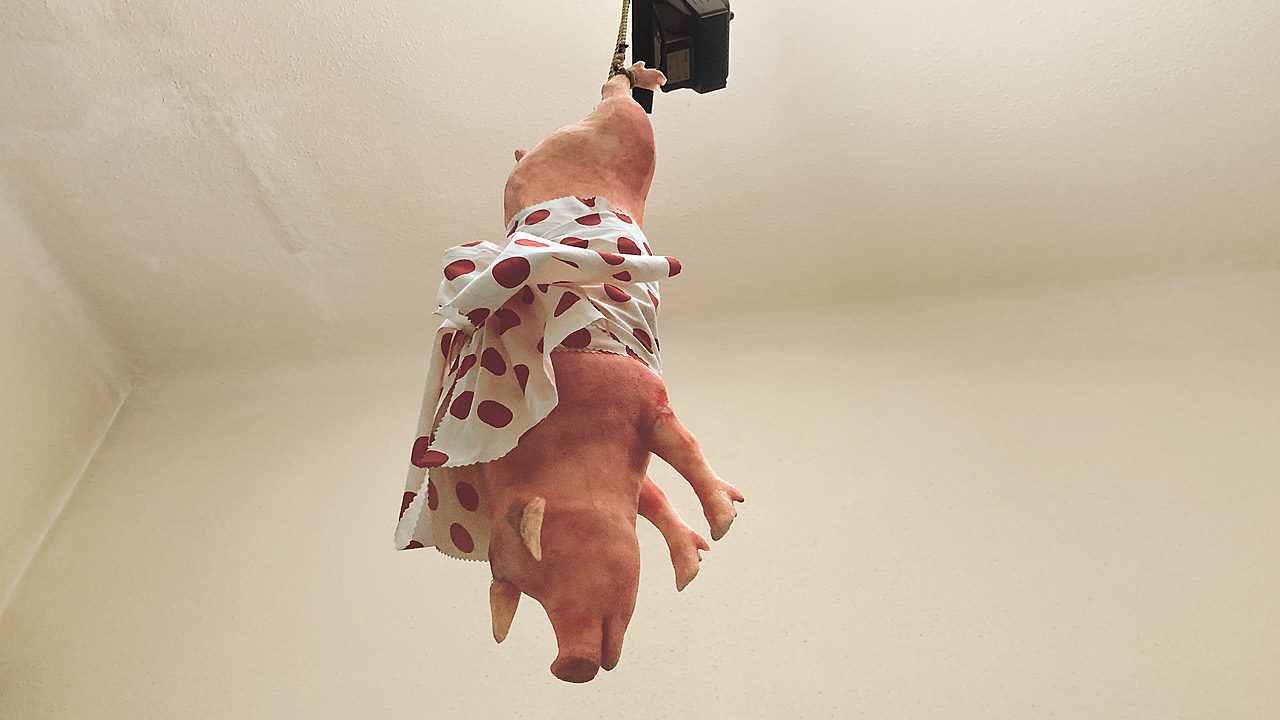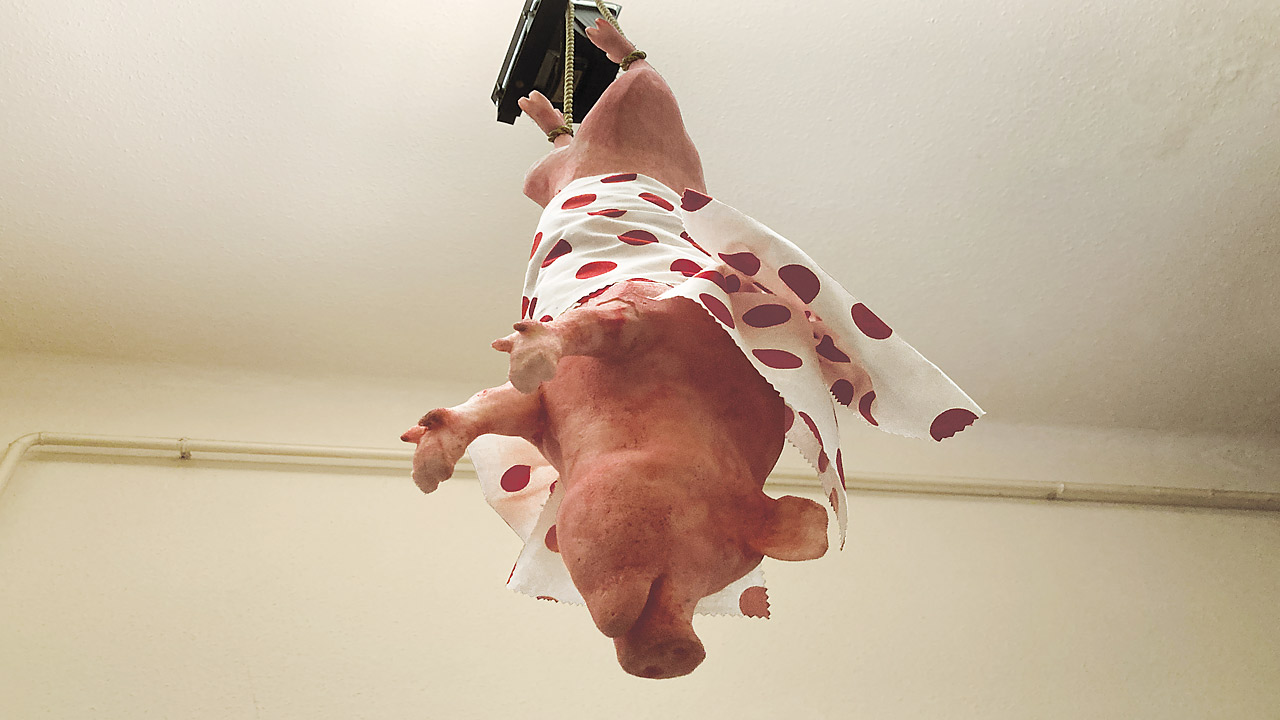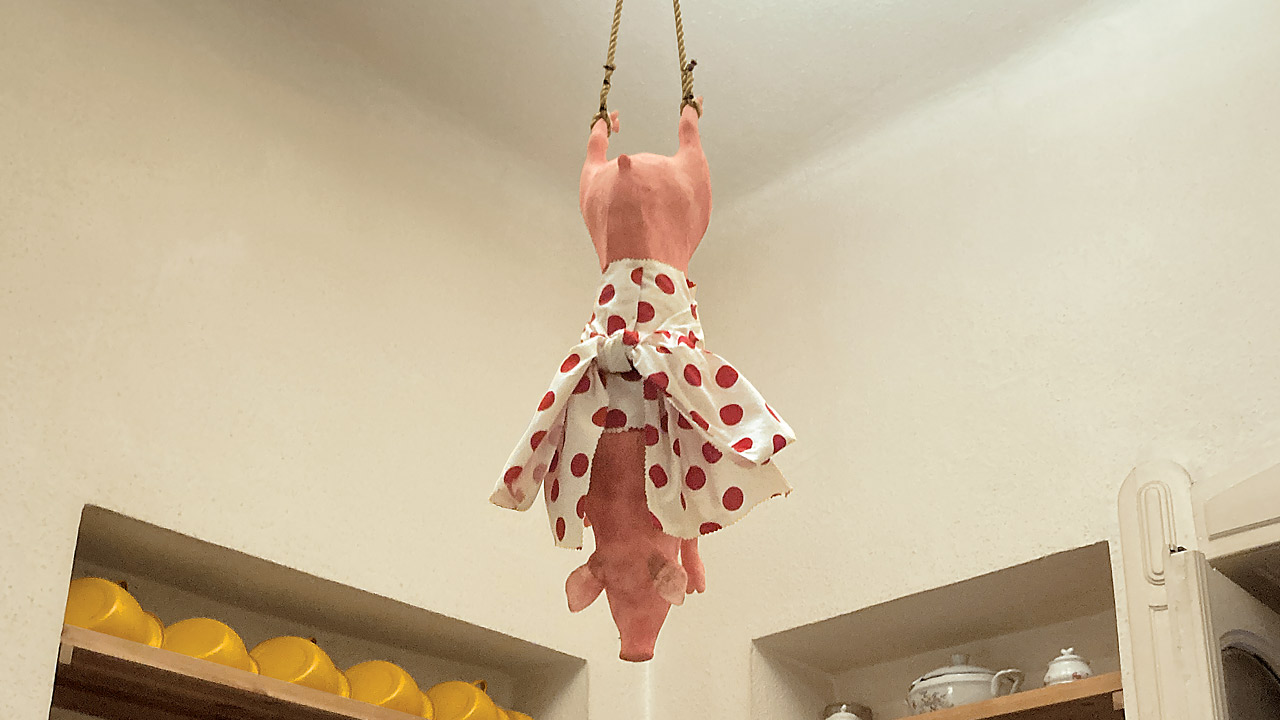Miniature Welfare
Genre: installation
Date: 2025
~ 45 x 45 x 90 cm
Materials: sponge, textile, rope
Kitchen, 52 2/2 Damjanich Street, Budapest, Hungary
Photo: Joseph Tasnádi
MINIATURE WELFARE
What do I mean when I say: pig
The pig’s anatomy deprives it of the ability to freely orient itself toward the sky.
In other words: in modern life – the pig – tends to shy away from ideal or philosophical questions. Here, in the earthly, material world – the pig – simply doesn’t feel the need to concern itself with the idea of a transcendent or ideal realm. It is not at all interested, for instance, in scenarios about the end of the world. For the pig, earthly survival and physical needs are paramount.
That the pig tends to look downward – reveals a deep attachment to material life, to consumption, and to the world of fixed cycles. The pig is simply and cheerfully – down-to-earth. A creature with limited perspective. It does not care for mythology.
The pig – is the rounded shape of the battle between flesh and spirit.
The question is whether man is the result of the pig’s anthropomorphization or whether they simply followed eerily similar evolutionary paths.
The pig’s greatest sin is that it does not chew the cud, despite its split hoof. It never managed to make itself worthy of being sacrificed to God.
The pig’s lust, mating habits, unrestrained sexual life – are simply outrageous. Not to mention that during its constant debauchery – it keeps gaining weight without end.
The pig – strictly from an economic point of view – is very close to humans. It’s a clingy type.
The pig – without question – possesses something demonic. It is desirable and appropriate to envision it seated right on the threshold of hell.
The pig’s behavior has evoked aversion from the beginning. All that wallowing – you know. Pigs wallow by nature. In the depths of its soul, the pig knows that to wallow it must have a universal perspective.
It is only the pig’s fault that its reputation has deteriorated from generation to generation. Despite this, its impact on the collective consciousness of humanity is undeniable.
Many pigs go so far as to take offense if compared to humans. The tragedy of humanity is that pigs ended up at the center of “ritual.” No pig has ever been known to call itself a “pig.”
It is an accepted biological fact that humans are bodily beings just like pigs. Therefore, among humans, declaring someone a pig is quite common. “Pig-calling” has been elevated to a kind of folk tradition.
Among pigs, one often hears: “we’re all humans here!” This is, without a doubt, a charming confession.
The pig – to this very day and at every turn – proves that elitism is out of the question for it, because the pig can only see the sky reflected in a puddle.
*********
MINIATŰR JÓLÉT
Mit mondok, ha azt mondom: disznó
A disznó testének felépítése megfosztja őt attól a képességtől, hogy szabadon orientálódjon az égbolt felé. Másképp fogalmazva: a modern életben – a disznó – hajlamos elzárkózni az eszményi vagy filozófiai kérdésektől.
Itt a földi, materiális világban – a disznó – egyszerűen nem érzi szükségét annak, hogy a transzcendens vagy az ideális világ elérhetőségének gondolatával foglalkozzon. Egyáltalán nem érdeklik például a világ végével kapcsolatos szcenáriók. Számára a földi túlélés és a testi szükségletek a legfontosabbak. Hogy a disznó inkább lefele szokott nézni – az a materiális élethez, a fogyasztáshoz és a rögzített ciklusok világához való mély kötődéséről árulkodik. A disznó egyszerűen és vidáman – földhözragadt. Korlátozott látószögű lény. Nem törődik a mitológiával.
A disznó – a hús és a szellem harcának gömbölyded alakja.
Kérdés, hogy az ember – a disznó antropomorfizációjának erdeménye-e vagy egyszerűen kísértetiesen hasonló eredményhez vezető evolúciós pályát követtek?
A disznó legnagyobb bűne, hogy nem kérődzik, pedig hasadt patájú. Sosem sikerült neki méltóvá tennie magát arra, hogy feláldozzák a jóistennek.
A disznó bujasága, párzási szokásai, féktelen szexuális élete – egyszerűen felháborító. Arról nem is beszélve, hogy a szüntelen paráználkodás közben – megállás nélkül hízik.
A disznó – szigorúan gazdasági szempontból – nagyon közel áll az emberhez. Ragaszkodó típus.
A disznóban – vitán felül – van valami démoni. Kívánatos és jogos őt egyenesen a pokol tornácán üldögélve vizionálni.
A disznó viselkedése már a kezdetektől fogva ellenszenvet váltott ki. Az a rengeteg dagonyázás – ugye. A disznók természetüknél fogva dagonyáznak. A disznó lelke mélyén tudja, hogy a dagonyázáshoz mindenképpen szüksége van az univerzális kitekintésre.
Csakis a disznó tehet róla, hogy megítélése generációról generációra romlott. Ennek ellenére tagadhatatlan az emberiség kollektív tudatára gyakorolt hatása.
Sok disznó odáig merészkedik, hogy kikéri magának, ha az emberhez hasolítják. Az ember tragédiája az, hogy a disznók kerültek a „rituálé” középpontjába. Nem ismert olyan disznó, amelyik önmagát „disznó”–nak nevezné.
Biológiai tényként elfogadott, hogy az ember éppúgy testi lény, mint a disznó. Ezért az emberek között gyakori a disznóvá nyilvánítás – mint olyan. A „disznózás” egyfajta népszokássá nemesült.
Disznók között gyakran hangzik el a: mindannyian „emberek” vagyunk! Ez kétségtelenül rokonszenvet keltő beismerés.
A disznó – mai napig és lépten nyomon – bizonyítja, hogy nála szóba sem jöhet az elitizmus, mert a disznó csak a tócsában láthatja az eget.





